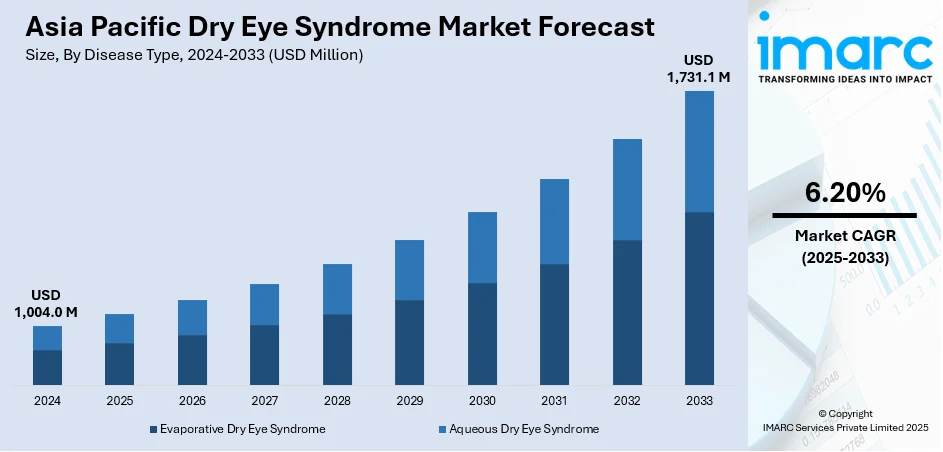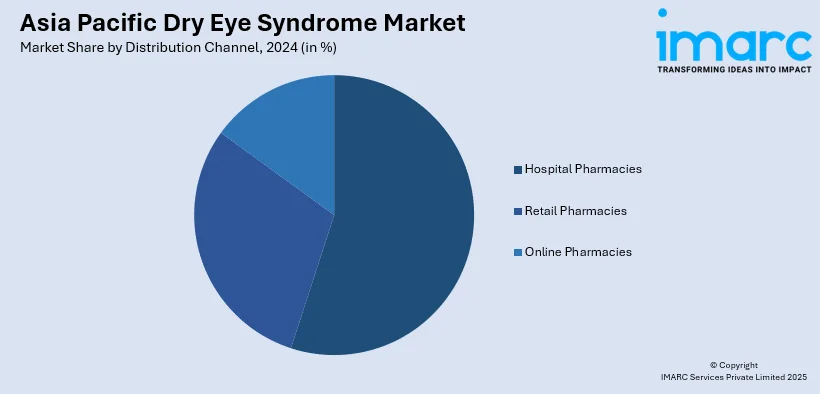
Asia Pacific Dry Eye Syndrome Market Size, Share, Trends and Forecast by Disease Type, Drug Type, Product, Distribution Channel, and Country, 2025-2033
Market Overview:
The Asia Pacific dry eye syndrome market size reached USD 1,004.0 Million in 2024. Looking forward, IMARC Group expects the market to reach USD 1,731.1 Million by 2033, exhibiting a growth rate (CAGR) of 6.20% during 2025-2033.
|
Report Attribute
|
Key Statistics
|
|---|---|
|
Base Year
|
2024 |
|
Forecast Years
|
2025-2033
|
|
Historical Years
|
2019-2024
|
| Market Size in 2024 | USD 1,004.0 Million |
| Market Forecast in 2033 | USD 1,731.1 Million |
| Market Growth Rate (2025-2033) | 6.20% |
Dry eye syndrome, or keratoconjunctivitis sicca (KCS), is a chronic disorder that occurs due to the lack of adequate moisture or lubrication on the surface of the eyes. It is a medical ailment characterized by various symptoms, such as aching, discomfort, burning, pain, redness, photophobia and irritation in the eyes. Dry eye syndrome is caused due to multiple factors, such as allergies, menopause, vitamins deficiency, laser surgery, autoimmune diseases and extensive screen time. It can be treated by administering artificial tears, surgeries, medications and lacrimal plugs. It can also be prevented by wearing wraparound sunglasses or other protective eyewear.

To get more information on this market, Request Sample
The growth in the Asia pacific dry eye syndrome market can be attributed to the increasing environmental pollution levels in the region. Dry eye syndrome is widely associated with prolonged exposure to dust, wind and dry climatic conditions that increases tear evaporation resulting in dry eye syndrome. In addition to this, the increasing utilization of laptops, smartphones and television among the masses leading to prolonged and excessive screen time is impacting the occurrence of the syndrome. Moreover, the utilization of secretagogues for the treatment of dry eye syndrome is providing a thrust to the market growth. It is widely used for stimulating the production of mucin and tears in the eyes. In line with this, the rising geriatric population prone to chronic eye-related diseases is positively impacting the market growth. Dry eye syndrome is also associated with various medical disorders, such as diabetes, Sjogren's syndrome, arthritis, thyroid disorders, lupus and scleroderma, which is highly prevalent in the elderly patients. Other factors, including the lack of physical activities among the masses resulting in increasing oxidative stress, along with the increasing healthcare expenditure capacities of the consumers, are creating a positive outlook for the market.
Key Market Segmentation:
IMARC Group provides an analysis of the key trends in each sub-segment of the Asia Pacific dry eye syndrome market report, along with forecasts at the country and regional level from 2025-2033. Our report has categorized the market based on disease type, drug type, product, and distribution channel.
Breakup by Disease Type:
- Evaporative Dry Eye Syndrome
- Aqueous Dry Eye Syndrome
Breakup by Drug Type:
- Anti-inflammatory Drugs
- Lubricant Eye Drops
- Autologous Serum Eye Drops
Breakup by Product:
- Liquid Drops
- Gel
- Liquid Wipes
- Eye Ointment
- Others
Breakup by Distribution Channel:

- Hospital Pharmacies
- Retail Pharmacies
- Online Pharmacies
Breakup by Country:
- China
- Japan
- India
- South Korea
- Australia
- Indonesia
- Others
Competitive Landscape:
The competitive landscape of the industry has also been examined along with the profiles of the key players.
Report Coverage:
| Report Features | Details |
|---|---|
| Base Year of the Analysis | 2024 |
| Historical Period | 2019-2024 |
| Forecast Period | 2025-2033 |
| Units | Million USD |
| Segment Coverage | Disease Type, Drug Type, Product, Distribution Channel, Country |
| Countries Covered | China, Japan, India, South Korea, Australia, Indonesia |
| Customization Scope | 10% Free Customization |
| Post-Sale Analyst Support | 10-12 Weeks |
| Delivery Format | PDF and Excel through Email (We can also provide the editable version of the report in PPT/Word format on special request) |
Key Questions Answered in This Report
We expect the Asia Pacific dry eye syndrome market to exhibit a CAGR of 6.20% during 2025-2033.
The rising environmental pollution levels, along with the prolonged and excessive screen time through laptops, smartphones, and television, is primarily driving the Asia Pacific dry eye syndrome market.
The sudden outbreak of the COVID-19 pandemic had led to postponement of elective treatments for dry eye syndrome to reduce the risk of the coronavirus infection upon hospital visits or interaction with healthcare professionals and medical equipment across several Asia Pacific nations.
Based on the disease type, the Asia Pacific dry eye syndrome market has been divided into evaporative dry eye syndrome and aqueous dry eye syndrome, where evaporative dry eye syndrome currently exhibits a clear dominance in the market.
Based on the drug type, the Asia Pacific dry eye syndrome market can be categorized into anti-inflammatory drugs, lubricant eye drops, and autologous serum eye drops. Currently, anti-inflammatory drugs account for the majority of the total market share.
Based on the product, the Asia Pacific dry eye syndrome market has been segregated into liquid drops, gel, liquid wipes, eye ointment, and others. Among these, liquid drops currently hold the largest market share.
Based on the distribution channel, the Asia Pacific dry eye syndrome market can be bifurcated into hospital pharmacies, retail pharmacies, and online pharmacies. Currently, hospital pharmacies exhibit a clear dominance in the market.
On a regional level, the market has been classified into China, Japan, India, South Korea, Australia, Indonesia, and others, where China currently dominates the Asia Pacific Dry Eye Syndrome market.
Need more help?
- Speak to our experienced analysts for insights on the current market scenarios.
- Include additional segments and countries to customize the report as per your requirement.
- Gain an unparalleled competitive advantage in your domain by understanding how to utilize the report and positively impacting your operations and revenue.
- For further assistance, please connect with our analysts.
 Request Customization
Request Customization
 Speak to an Analyst
Speak to an Analyst
 Request Brochure
Request Brochure
 Inquire Before Buying
Inquire Before Buying




.webp)




.webp)












